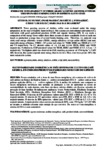Use este identificador para citar ou linkar para este item:
http://biblioteca.incaper.es.gov.br/digital/handle/item/998| Título: | Energetic sustainability of three arabica coffee growing systems used by family farming units in Espírito Santo state. |
| Autor(es): | DE MUNER, L. H.  MASERA, O.   FORNAZIER, M. J.   SOUZA, C. V. de.   LORETO, M. das D. S. de.   Lucio Herzog De Muner, Incaper; Omar Masera, UNAM; Mauricio José Fornazier, Incaper; Cássio Vinícius de Souza, Incaper; Maria Das D. S. de Loreto, UFV.   |
| Palavras-chave: | Agroecossistema Análise energética Café arábica Produtividade Sustentabilidade |
| Data do documento: | 31-Ago-2015 |
| Editor: | In: Engenharia Agrícola, Jaboticabal, v. 35, n. 3, p. 397-405, june 2015. |
| Descrição: | Three growing systems of Arabica coffee were evaluated under the energy perspective, in the state of Espírito Santo in Brazil. The systems are conventional cultivation (CC), cultivation with good agricultural practices (CGP) and organic farming (OF). It was made a comparison of the energy flows within these three systems to show sustainable levels of each one based on production average data of several family-farming units. Therefore, we analyzed crop yield, total energy efficiency reverse (TEER), energy efficiency of ripe coffee (EERC) and non-renewable energy efficiency (NREE). OF system had values for TEER, EERC and NREE of 3.3 4.7 and 7.9 respectively. Yet CC showed values of 1.8, 1.9 and 1.6 for TEER, EERC and NREE respectively. Furthermore, CGP presented values for TEER, EERC and NREE of 0.7, 1.3 and 1.4 respectively. The highest yield was observed in CGP, reaching an amount of 1794 kg ha-1(17,455 MJ); however, this system expends more energy than it converts. Thus, over those points, OF is the most sustainable system. Foram estudados, sob a ótica de seus fluxos energéticos, três sistemas de cultivo de café arábica no Estado do Espírito Santo: a - cultivo convencional (CC); b - cultivo com as boas práticas agrícolas (BPA), e c cultivo orgânico (CO). A análise foi realizada para comparar os fluxos energéticos envolvidos nos sistemas de produção, a fim de apresentar os níveis de sustentabilidade de cada sistema, com base em dados médios obtidos em diversas unidades de produção de base familiar. Os indicadores analisados foram: Produtividade, Eficiência Energética Total Invertida (ETI), Eficiência Energética Café Maduro (ECC) e Eficiência Energia não Renovável (ENR). O sistema de CO apresentou valores para ETI, ECC e ENR de 3,3; 4,7 e 7,9, respectivamente. O sistema de CC apresentou valores para ETI, ECC e ENR de 1,8; 1,9 e 1,6; respectivamente. O sistema de BPA apresentou valores para ETI, ECC e ENR de 0,7; 1,3 e 1,4; respectivamente. A maior produtividade ocorreu no sistema de BPA, com 1794 kg ha-1(17.455 MJ); no entanto, o referido consome mais energia do que converte. Do ponto de vista energético, o sistema de CO é o mais sustentável. |
| URI: | http://biblioteca.incaper.es.gov.br/digital/handle/item/998 |
| Aparece nas coleções: | Memória Técnica do Incaper  |
Arquivos associados a este item:
| Arquivo | Descrição | Tamanho | Formato | |
|---|---|---|---|---|
| energeticsustainabilityofthree.pdf | 198,79 kB | Adobe PDF |  Visualizar/Abrir |
Os itens no repositório estão protegidos por copyright, com todos os direitos reservados, salvo quando é indicado o contrário.
